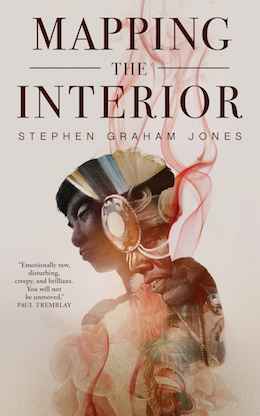It begins, like so many hauntings do, with a house.
Junior’s house, though, is not your typical haunted home: it’s not old, has no secret compartments or hidden historical artifacts, and no one has died there. Junior lives with his mom and his little brother Dino in a modular house, cheap and small and different from a trailer only in that it stays put. “You can leave the reservation,” he overhears his mom say, “but your income level will still land you in a reservation house.” And just like that, they’ve brought their ghost from the reservation as well. When Junior sees him one night, dressed in full fancy dance regalia, he knows immediately that the ghost is his dad. He also knows that he’ll do whatever it takes to make him come back.
Stephen Graham Jones’ new Tor.com novella, Mapping the Interior, is a ghost story and a coming-of-age story; it’s a horror story with race and class breathing down the reader’s neck every bit as much as the dead. It’s also not quite like any version of those things you’ve read before. If most hauntings are metaphysical, Jones’ is physical: the legacy of Junior’s father is written on his body as well as his memory.
There’s no reason for Junior to know the ghost is his dad (he died when Junior was just four years old), just as there’s no reason for the ghost to have been able to find his family so far from the reservation. But Junior knows, nonetheless, right when he sees the feathers and undulating movements that signify the competitive dancing of his community. His father was never a fancy dancer during his lifetime, though he aspired to become one someday, if he could just turn his life around. “That’s how you talk about dead people, though,” Junior explains, “especially dead Indians. It’s all about squandered potential, not actual accomplishments.” In death, though, his father has ascended. In death, he has returned to take care of his family, as he had never done in life.
With Dino getting sicker by the day, Junior can no longer protect him from every bully, or even from the neighbor’s dogs that threaten them on the way home from school. His mother, too, can only do so much when she’s working long hours and cut off from her family. Junior is convinced that he can make his father manifest more permanently if he can just find where in the house he’s coming from. And so he begins to map the interior. Every inch could hold the key to saving Dino, every buried piece of trash could be the gift that makes their father stay. To recreate his first vision, Junior tries to mimic its original circumstances: sleepwalking, tying his legs down tight to force them asleep, constantly struggling to see things out of the corner of his eye. As Dino gets sicker, and as Junior begins finally to dig underneath the house, their father becomes clearer and clearer everyday.
Considering Mapping’s brevity and (even moreso) its horror elements, it’s a difficult story to summarize without spoiling. I can only hope that the gesture I’ve given to its creeping story and disturbing conclusion will encourage readers to pick it up. Junior’s small, narrow home, and his first-person perspective make for a claustrophobic narrative, one that is perfectly suited for its novella form. The more obvious horror elements, too, are fitting: encounters with the ghost and its timeline are aching rather than shocking, upsetting rather than scary. They are bruising, like the residue of grief.
I had never read any of Jones’ large oeuvre before this, but after reading Mapping, I can’t help but be drawn to it. Native American perspectives (let alone specifically Blackfeet ones) are rarely highlighted in any genre. Bringing Jones’ background and sensibility to the haunted house trope reinvigorates it, and highlights the recursive relationship between memory and culture. Junior, with his unreliable narration and child’s logic for the world’s cruelty, makes for a compelling protagonist of such a story. And finally, Mapping the Interior is gorgeously-paced, with just the right combination of understatement and profundity. It’s not to be missed.
Mapping the Interior is available from Tor.com Publishing.
Emily Nordling is a library assistant and perpetual student in Chicago, IL.










